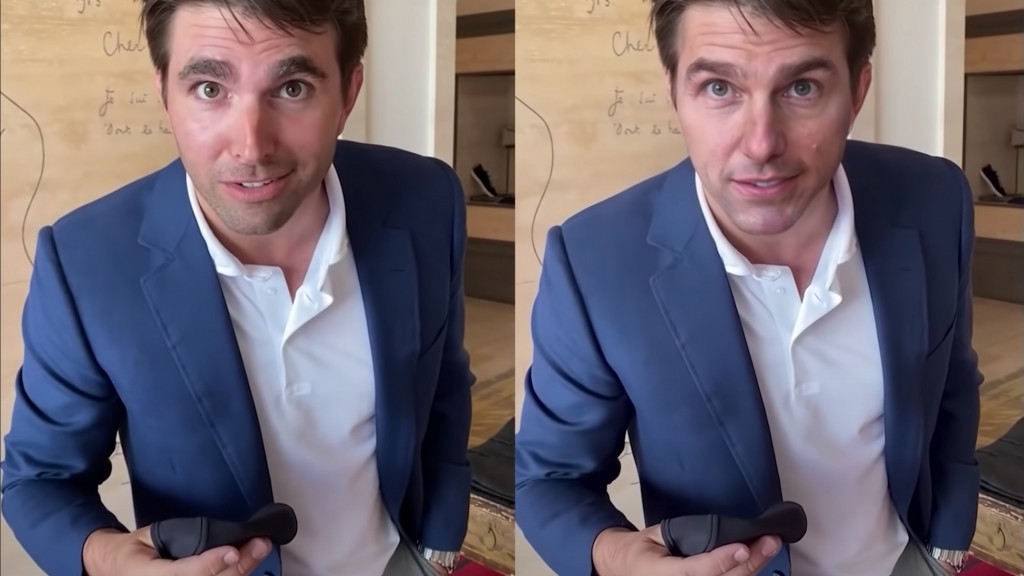Deepfakes & Film
Deepfake technologies are become increasingly accessible and easier to use over time. In what ways can deepfakes be used for entertainment content? What opportunities could deepfake provide for the movie industry? And what legal or moral issues might arise when using deepfakes for content creation? This is the third blog of a four-part series in which different applications and impacts of deepfake technologies will be explored.
Deepfake technologies are become increasingly accessible and easier to use over time. In what ways can deepfakes be used for entertainment content? What opportunities could deepfake provide for the movie industry? And what legal or moral issues might arise when using deepfakes for content creation? This is the third blog of a four-part series in which different applications and impacts of deepfake technologies will be explored.

Deepfake of Tom Cruise created by Chris Ume by collaborating with impersonator Miles Fisher (left). Source: VFXChris Ume/YouTube

Deepfake recreation of Tarkin & Leia in Rogue One. Source: Shamook/Youtube
Perhaps you remember when, in 2016, the movie Rogue One: A Star Wars Story was released by Disney. Although it received many positive reviews, quite some people seemed to be critical of the digital resurrection of two deceased actors, Peter Cushing and Carrie Fisher, indicating that these recreations looked creepy and videogame-like. In actuality, however, they used Computer-Generated Imagery (CGI), which is a commonly used technique in the Hollywood film industry for the creation of specific sceneries, special effects and characters in movies. Following the criticism on Rogue One, the YouTube channel Shamook, known for making alternate recreations of famous movie scenes by using deepfake technologies, attempted to reproduce the scenes with Cushing and Fisher to make them look more realistic.

TikTok videos of a deepfaked Tom Cruise. Source: VFXChris Ume/Youtube
Besides Shamrock, there are already several other examples of social media channels that use deepfakes to recreate famous actors, often as a form of entertainment or parodies. The Youtube channel Ctrl Shift Face, for example, posts edits of famous actors who are deepfaked into movies they have never played in. One of his most viewed parodies called “Home Stallone” shows a recreation of the famous Christmas movie Home alone in which the main character Kevin now has the face of the actor Sylvester Stallone. Another example can be found on TikTok, where a creator called Chris Ume has an account named deeptomcruise where he posts all sorts of videos in which the actor’s typical mannerisms, such as his laugh, are slightly over-emphasised and exaggerated.
Considering that all of these variations are already being made and spread all over the internet, it would perhaps seem that, compared to CGI, this type of technology can become a great money saver for big-budget films and there are a variety of ways in which AI technologies could be beneficial within the movie industry. Deepfakes could, for instance, be used to realistically dub movie actors in foreign languages, to (de-)age an actor’s face or even revive deceased actors. Some more creative speculations were that maybe, one day, films could be shot with just any unknown person and you might be able to choose afterwards which actor you want to see in a specific movie. Or perhaps you might even be able to watch those films with yourself as the main character.

A deepfake video, made for entertainment purposes, showing an impressionist who recites a poem in 20 different celebrity voices whilst morphing into each of their faces. Source: Jim Meskimen/Youtube
However, if Hollywood were to implement deepfake technologies in their films in the near future, there might be a couple of things that will have to be taken into account. In the case of resurrecting a deceased actor, for instance, there will likely arise some issues. Some actors might protect their own image even after their passing, for example, such as Robin Williams who restricted any use of his image for 25 years after his death by handing over his copyright to a charity foundation. This means that his image can never legally be used by any other organisation, which would make it impossible by law to revive a digitalised version of him within that time frame. Moreover, even if an actor did not restrict the use of their image after their death, there would still be an important moral issue to consider. In 2019, for example, a controversy arose when plans were announced to digitally resurrect the famous actor James Dean (who died in 1955) to become the main character of a film called Finding Jack. This decision, however, has been met with much criticism from several Hollywood actors who believe it is morally unacceptable to bring someone back to life without their consent. Nonetheless, it will likely be a matter of time before deepfake technologies will become widely adopted in the movie industry. In fact, Disney Research published a new paper in which details are given about how they managed to create an improved, high-resolution deepfake that might, one day, massively boost the company’s film-making methods. In the meantime, though, people around the world can already make their own funny deepfake recreations or variations of their favourite actors or movie scenes.
The next blog post will be discussing deepfakes & misinformation: how could deepfakes be used to spread misinformation? Are deepfakes truly as dangerous as they are sometimes thought to be? And if so, what dangers could we expect in the future?
My name is Rebecca Haselhoff, an MA student of Media Studies: Digital Cultures at Maastricht University. I’m doing a research internship at Beeld & Geluid, focusing on deepfake technologies
